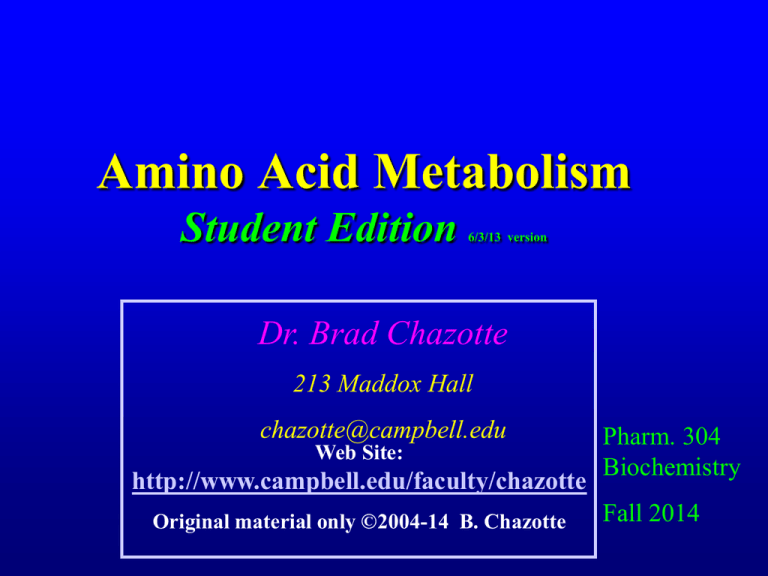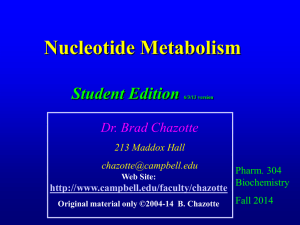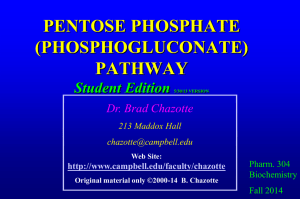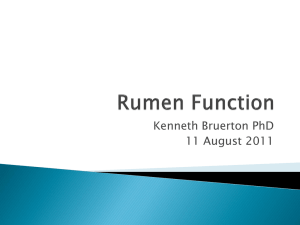Biochemistry 304 2014 Student Edition Amino Acid Metabolism
advertisement

Amino Acid Metabolism
Student Edition
6/3/13 version
Dr. Brad Chazotte
213 Maddox Hall
chazotte@campbell.edu
Web Site:
http://www.campbell.edu/faculty/chazotte
Original material only ©2004-14 B. Chazotte
Pharm. 304
Biochemistry
Fall 2014
Goals
• Understand the relationship of nitrogen to carbon
intermediary metabolism.
• Learn the Urea Cycle sequence, reactions, and products.
• Have an understanding of an overview of amino acid
catabolism resulting in 7 basic products and the difference
between ketogenic and glucogenic catabolism.
• Have an understanding of an overview of amino acid
anabolism from basic precursors.
• Understand the concept of essential and nonessential
amino acids in the diet of humans.
• Understand that many diseases can arise from errors in
amino acid metabolism.
Do NOT memorize any of the specific amino acid catabolic or
anabolic pathways. They are for informational purposes only.
Nitrogen
Pathways in
Intermediary
Metabolism
Plants
Matthews et al 2000 Figure 20.1
Dietary Amino Acids in Metabolism
“Excess dietary amino acids are not simply excreted but are
converted to common metabolites that are precursors of glucose,
fatty acids, ketone bodies – and are therefore metabolic fuels”
Voet, Voet & Pratt 2008 p.732
Protein Synthesis & Degradation
1.
Nutrient storage as protein; break proteins down in times of metabolic
need (muscle a prime source)
2.
Eliminate accumulation of abnormal proteins that would harm the cell
3.
Permit the regulation of cellular metabolism by the elimination of
unneeded enzymes and regulatory proteins.
Voet, Voet & Pratt 2008 p.733
Catabolism
Cellular Protein Degradative Routes
Lysosomal - a cellular compartment at ~pH 5 containing
hydrolytic enzymes (cathepsins). Degrade substances
taken up by endocytosis. Recycle intracellular constituents
enclosed within vacuoles. In “well nourished cells” protein
degradation is nonselective. In starving cells a selective
pathway is activated that imports and degrades proteins
that contain the pentapeptide (Lys-Phe-Glu-Arg-Gln;
KFERQ) e.g., in muscle and liver, but not brain.
Ubiquitin-Based – ATP-based process independent of
lysosomes. Proteins are marked for degradation by linking
to ubiquitin.
Rx Involved in Protein
Ubiquination
Proteasome
Matthews et al 2000 Figure 20.10
Voet, Voet & Pratt 2013 Fig 21.2
Matthews et al 2000 Figure 20.11
Voet, Voet & Pratt 2013 Fig 21.4
Distinguishing Protein Lifetimes
The N-end Rule:
N-terminal residues Asp, Arg, Leu, Lys & Phe
half-life ~ 2-3 minutes
Ala, Gly, Met, Ser Thr, & Val
half-life > 20 hrs in eukaryotes
(>10 prokaryotes)
PEST proteins Proteins with segments rich in
Pro, Glu, Ser, & Thr are rapidily degradedthese AA have sites that can be phosphorylated
– thus targeting them for ubiquitination.
Voet, Voet & Pratt 2013 Table 21.1
Some Cellular Processes
Regulated by Protein Degradation
e.g,NF-κB –I κB system
Berg, Tymoczko, & Stryer 2012 Table 23.3
Protein
(“Macro”)
Digestion in the
Human
Gastrointestinal
Tract
Berg, Tymoczko, & Stryer 2012 Figure 23.1
Lehninger 2000 Figure 18.3
Amino Acid Catabolism:
Overview
Amino acid degradation includes a key step of separating the amino
group from
the carbon skeleton.
Lehninger 2004 Figure 18.1
Voet, Voet & Pratt 2013 Fig 21.6
Amino Acid Deamination
Transamination - most
amino acids are deaminated
by this process carried out by
transaminases
(aminotransferases). Amino
group of amino acid is
transferred (predominately)
to -ketoglutarate
Voet, Voet & Pratt 2013 Chap. 21 page 719
Oxidative Deamination – of glutamate by
glutamate dehydrogenase yields ammonia
and -ketoglutarate
Voet, Voet & Pratt 2013 Chap. 21 page 722
Forms of Pyridoxal-5’Phosphate
Needed by
aminotransferases
as a coenzyme.
Voet, Voet & Pratt 2013 Fig 21.7
PLP-Dependent Enzyme Catalyzed
Transamination Mechanism
Voet, Voet & Pratt 2013 Fig 21.8
Oxidative Degradation of Amino Acids
Occurs under three different circumstances in animals:
1) During normal homeostasis
2) Protein-rich diet
3) Starvation or uncontrolled diabetes mellitus
Lehninger 2000 Chapter 18
Glutamate Dehydrogenase
(Oxidative Deamination)
A mitochondrial enzyme yielding ammonia and -ketoglutarate
It is the only enzyme that can accept either NAD+ or NADP+ as
a coenzyme
G° = ~30 kJ mol-1
Due to the high toxicity of ammonia – it is important that under
physiological conditions G ≈ 0, i.e. at equilibrium.
mammalian liver
Lehninger 2000 Figure 18.7
Ammonia Transport to Liver for
Urea Synthesis
Matthews et al 2000 Figure 20.14
Lehninger 2000 Figure 18.8
Urea Cycle
Urea Cycle Enzymes
(1) Carbamoyl Phosphate synthetase (mitochondrion)
(2) Ornithine transcarbamoylase
(mitochondrion)
(3) Argininosuccinate synthetase
(cell cytosol)
(4) Argininosuccinase
(cell cytosol)
(5) Arginase
(cell cytosol)
Overall Urea Cycle Reaction
Voet, Voet & Pratt 2013 Chap 21 p 723
Urea Cycle
& Feeder Reactions
Voet, Voet & Pratt 2013 Fig 21.9
Lehninger 2000 Figure 18.9
Urea Cycle Diagram
Lehninger 2000 Figure 18.9
Nitrogen-acquiring reactions in
Urea Synthesis
Lehninger 2004 Figure 18.11
Linking the Urea & Citric Acid Cycles
“ Krebs ‘Bicycle’ ”
Lehninger 2004 Figure 18.12
AA Degradation to 1 of 7
Common Intermediates
Voet, Voet & Pratt 2013 Fig 21.13
Glucogenic vs Ketogenic
Amino Acid Degradation
• Glucogenic - degradation lead to glucose
precusors: pyruvate, α-ketoglutarate,
succinyl-CoA, fumarate or oxaloacetate
• Ketogenic – degradation leads to fatty acids
or ketone body precursors: acetyl-CoA or
acetoacetate
• Some amino acids are gluco- and keto-genic
Examples of a Few Disorders of Human
Amino Acid Catabolism
PKU
Tyrosimenia I, II, or III
Rx 5, 2, or 4- respectively {side 35}
Lehninger 2000 Table 18.2
Anabolism
Human Essential & Non-Essential
Amino Acid
Voet, Voet & Pratt 2013 Table 21.3
Amino Acid Biosynthetic Families
CAC
Glycolysis
PP
Glycolysis
PP
CAC
Lehninger 2000 Table 22.1
Metabolic Relationships Among Amino
Acids Derived from Citric Acid Cycle
Intermediates
Essential Human
amino acid
THOSE AA HIGHLIGTED BY AN ORANGE BOX ARE
ESSENTIAL AMINO ACIDS FOR HUMANS.
Matthews et al 2000 Figure 21.1
Biosynthesis of Non-Essential Amino
Acids
With the exception of tyrosine, all the nonessential amino acids
come from one these four metabolic intermediates: pyruvate,
oxaloacetate, α-ketoglutarate, and 3-phosphoglycerate.
End of Lecture Materials
Supplementary Material on
Amino Acid Catabolism
• This material will NOT be on any test and
is for informational purposes only.
Pathways for Ala, Cys, Gly, Ser &
Thr to Pyruvate
Voet, Voet & Pratt 2008 Fig 21.14
Serine Dehydratase
Voet, Voet & Pratt 2008 Fig 21.15
Pathways for
Arginine,
Glutamate,
Glutamine,
Histidine &
Proline to ketoglutarate
Voet, Voet & Pratt 2008 Fig 21.17
Methionine Degradation
Voet, Voet & Pratt 2008 Fig 21.18
TetraHydroFolate
2-State Reduction of Folate to THF
Voet, Voet & Pratt 2008 Table 21.2, Fig 21.19
Branched-Chain AA Degradation
Voet, Voet & Pratt 2008 Fig 21.21
Saccharopine
dehydrogenase
Saccharopine
dehydrogenase
aminoadipate semialdehyde
dehydrogenase
Mammalian
Liver Lysine
Degradation
Sminoadipate
aminotransferase
Α-keto acid
dehydrogenase
Enoyl-CoA
dehydratase
Glutaryl-CoA dehyd.
decarboxylase
Β-hydrozyacylCoA
dehydrogenase
HMG-CoA synthase
HMG-CoA lyase
1
Voet, Voet & Pratt 2008 Fig 21.22
Tryptophan Degradation
Tryptophan-2,3dioxygenase
formamidase
Kynureninase-3monooxygenase
Kynureninase
Voet, Voet & Pratt 2008 Fig 21.23
Phenylalanine Degradation
Phenylalanine
hydroxylase
Tyrosine
aminotransferase
p-hydroxyphenyl
pyruvate dioxygenase
Homogentisate
dioxygenase
fumarylacetoacetase
Voet, Voet & Pratt 2008 Fig 21.24
Supplementary Information of
Amino Acid Anabolism
• The information in the slides hereafter is for
informational purposes only, if you are
interested, and will NOT be part of any test.
• Amino acid degradative and biosynthetic
pathways are sites for a significant number
of illnesses and/or genetic defects.
Alanine, Aspartate, Glutamate, Asparagine
& Glutamine Syntheses (Non-essential)
Voet, Voet & Pratt 2008 Fig 21.27
Glutamate
“Family”
Syntheses:
Arginine,
Ornithine
& Proline
γ-glutamyl kinase
Glutamate
dehydrogenase
Path in
mammals
Pyrroline carboxylate
reductase
Voet, Voet & Pratt 2008 Fig 21.30
3-Phosphoglycerate Serine
Conversion
3-phosphoglycerate
dehydrogenase
Phosphoserine
aminotransferase
Phosphoserine
phosphotase
Voet, Voet & Pratt 2008 Figure 21.31
Biosynthesis of Essential Amino Acids
Biosyntheses
of Aspartate
“Family”:
Lysine,
Methionine,
& Threonine
Voet, Voet & Pratt 2008 Fig 21.32
Biosyntheses
of the
Pyruvate
“Family”:
Isoleucine,
leucine &
Valine
Voet, Voet & Pratt 2008 Figure 21.33
Biosyntheses
of
Phenylalanine,
Tryptophan,
& Tyrosine
Voet, Voet & Pratt 2008 Fig 21.34
Biosynthesis of Histidine
Voet, Voet & Pratt 2008 Fig 21.36
Heme
Biosynthesis
Voet, Voet & Pratt 2008 Fig 21.38
Summary:
Glucogenic
& Ketogenic
Amino Acids
Lehninger 2000 Figure 18.29
Amino Acid Biosynthesis: Overview I
Lehninger 2000 Figure 22.9a
Amino Acid Biosynthesis: Overview II
Lehninger 2000 Figure 22.9b
Amino Acid Biosynthesis: Overview III
Lehninger 2000 Figure 22.9c
End of Supplementary
Material









